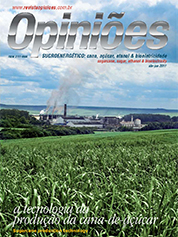Gilson Christofoli Junior
Agricultural Director of Renuka - Equipav Unit
Op-AA-28
A route of no return
Until recently, good rural labor management was fundamentally important to optimize sugarcane production. This is what occurred because harvesting and planting activities were always predominantly performed manually. In recent years, factors such as environmental pressure to end burning, labor problems and the industry’s expansion to low population density areas, among others, made the sugarcane-based industry go through a quick mechanization process, first in harvesting, and more recently in planting.
With that, managing rural labor lost relative importance, so nowadays we are looking for efficiency and quality in mechanized activities. The expansion of mechanical harvesting and planting, mainly in the last 5 or 6 years, was greater than our capacity to train labor, from an operational and maintenance point of view.
Nowadays, our first and foremost challenge is to train harvester operators, mechanics, electricians and leaders who can manage the entire mechanization process. The solution lies in mills heavily investing in training and education of such professionals.
However, since mechanization is still under development, with the coming on stream of new production units, I trust this situation will still require many years before it stabilizes. Efficiency in mechanized operations necessarily involves integrating the areas responsible for agricultural activities and vehicle maintenance. In mills it is quite common to see relational conflict unfold between these areas.
Only with perfect synergy between them is it possible to develop efficient procedures for predictive and preventive maintenance, combat operational breakdowns, and hence, reduce corrective maintenance. In that way, we can work at low costs and realize agricultural activities at the right time. With respect to mechanical planting per se, the subject matter of this article, what one observes is that over the years, it enjoyed significant development in terms of quality.
This evolution occurred to a lesser degree due to technological improvements in seed cane planters and harvesters, and mainly due to continuous learning and development of better agronomic techniques applied to mechanical planting.
Although Units exist in which the quality of mechanical and manual planting is very close, there is still a long way to go. Just remember that the quantity of seed cane used in mechanical planting is significantly higher than in manual planting, and even so, quite often one does not achieve the same result in terms of quality.
So, I believe our greatest objective in mechanical planting is to increasingly improve quality in relation to manual planting, while at the same time being able to reduce the quantity of seed cane used. This is really a great challenge, since the reduction in the quantity of seed cane goes contrary to planting quality.
There is no simple solution for this objective other than much work, study and improvement. One must work with all variables that interfere in the quality of mechanical planting. The two variables to work on are: damage reduction in seed cane, both of buts and billets, and improvement of the seed cane distribution system by planters. These two variables will have direct influence in reducing the quantity of seed cane used and errors made in planting.
To that end we must work together with cane harvester and planter manufacturers, so as to develop equipment technology and operational quality. Support from an active and well-trained quality control team quickly signals any non-conformity, allowing for immediate corrective action and problem solving. Agronomic issues are also very important in this process, since cane variety, its quality and size at the time of harvesting, are essential for the success of mechanical planting.
The manual planting system is characterized by good distribution quality of seed cane in the planting furrows, and the closer mechanical planting gets to this reality, the greater the chances of success. Several other factors influencing planting quality cannot be overseen, such as soil preparation quality, preparation of the terrain, furrow depth, coverage quality and depth, soil humidity at the time of planting, among others.
The importance of training, qualification and education of the labor force has already been mentioned, however, one should emphasize that the work performed by planter operators is determinant for planting quality. With respect to parallelism of furrows, nowadays technological progress has already occurred by using GPS devices.
It is also important that everybody well know soil and climate characteristics, as well as the cane varieties cultivated and the machines used, so that technology may be adapted to each reality. Another important advantage of mechanical planting is that furrowing and covering operations take place at the same time, without loss of humidity, allowing us to increase the actual planting period.
With progress achieved in quality and with the reduction in the quantity of seed cane used in mechanical planting, it becomes indisputable, given that it has lower operational costs in comparison with manual planting. Thus, mechanical planting is a route of no return.




